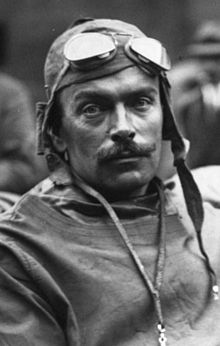| Louis Wagner | |||||||
|---|---|---|---|---|---|---|---|
 Wagner in 1914 Wagner in 1914 | |||||||
| Born | Louis Auguste Wagner (1882-02-05)5 February 1882 Le Pré-Saint-Gervais, Seine, France | ||||||
| Died | 30 March 1960(1960-03-30) (aged 78) Montlhéry, Seine-et-Oise, France | ||||||
| Championship titles | |||||||
| Major victories Vanderbilt Cup (1906) | |||||||
| Champ Car career | |||||||
| 2 races run over 2 years | |||||||
| First race | 1911 American Grand Prize (Savannah) | ||||||
| Last race | 1919 Indianapolis 500 (Indianapolis) | ||||||
| |||||||
| 24 Hours of Le Mans career | |||||||
| Years | 1925–1926 | ||||||
| Teams | Ariès, Peugeot | ||||||
| Best finish | 6th (1925) | ||||||
| Class wins | 0 | ||||||
Louis Auguste Wagner (5 February 1882 – 13 March 1960) was a French racing driver who won the American Grand Prize and the inaugural British Grand Prix. Wagner was also a pioneer aviator.
Early life
Wagner was born in Le Pré-Saint-Gervais, located in what is now the Seine-Saint-Denis department.
Motor racing
Wagner began racing cars while in his teens and claimed victory in 1903 driving a Darracq in a voiturette class race at the Circuit des Ardennes at Bastogne, Belgium. Wagner was one of the drivers for the Darracq team in the 1904 Gordon Bennett Cup in Germany that finished 8th and in 1905 at the Circuit d'Auvergne in Clermont-Ferrand, he was eliminated in the first round.
Competing in the United States, Wagner won the Vanderbilt Cup of 1906 driving a Darracq model 120 over a Long Island racecourse. He finished fifth in the 1907 Kaiserpreis in Germany but the following year in Savannah won the first ever United States Grand Prix driving a Fiat.

Driving a Mercedes, Wagner finished second to Christian Lautenschlager in the 1914 French Grand Prix at Lyon.
Wagner served his country during the First World War, fighting in the French Artillery division.
Wagner competed in the 1919 Indianapolis 500 driving a Ballot but went out with a broken wheel on lap 45. In 1924 he drove for the Alfa Romeo team, in a P2 alongside Antonio Ascari and Giuseppe Campari.
In 1926, after relieving Robert Sénéchal on lap 83, Wagner drove to victory in the first ever British Grand Prix. Wagner's Delage 155B had dropped out with mechanical issues on the sixth lap of the 110-lap race.
In August, Wagner won the Grand Prix de la Baule, held on a temporary beach course, in a Delage 2LCV. In addition to Grand Prix racing, Wagner also competed in the 1925 24 Hours of Le Mans together with fellow countryman Charles Flohot in a Ariès Type S GP, they finished sixth overall, and second in class 3.0. In 1927 Wagner came second overall at the Coppa Florio and won his class +3.0 in a Peugeot.
Aviation
Wagner began flying airplanes in 1910. He worked for the Hanriot company flying their monoplanes.
Later life and death
During World War 2 Wagner was diagnosed with tuberculosis of the bone, compelling the amputation of a leg. Wagner was given the post of instructor and supervisor at the Montlhery circuit, but the disease worsened, by the late 1950s he was housebound. In 1955 Wagner was awarded the Legion d'Honneur for distinguished service in the First World War, although it had been delayed 37 years as a criticism of his racing for Mercedes-Benz shortly before that conflict began.
Wagner died on March 13, 1960, at the age of 78 in Montlhéry, France.
Motorsports career results
Indianapolis 500 results
|
| |||||||||||||||||||||||||||||||||||||||||
See also
References
- EarlyAviators.com ; Louis Wagner
- "British Grand Prix". Motor Sport. 3 (3): 69–72. September 1926.
- Champagne| Berceau de l'aviation du Monde; Louis Wagner
External links
- Louis Wagner wins the 1906 Vanderbilt Cup Race (VanderbiltCupRaces.com)